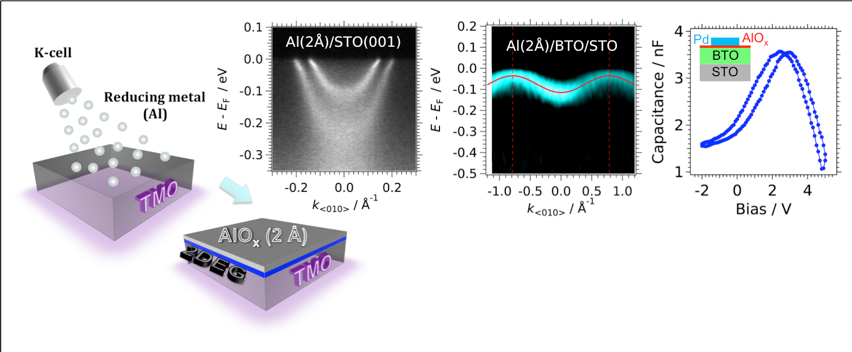T. C. Rödel, F. Fortuna, S. Sengupta, E. Frantzeskakis, A. F. Santander-Syro (CSNSM), P. Le Fèvre, F. Bertran (Synchrotron SOLEIL), S. Matzen, G. Agnus, T. Maroutian, P. Lecoeur (C2N)
Two-dimensional electron gases (2DEGs) in transition metal oxides (TMOs) can show metal-to-insulator transitions, superconductivity, magnetism, or spin-polarized states, and are thus an active field of research promising for applications beyond semiconductor technology. However, their fabrication and use, essentially limited to heterostructures based on SrTiO3(STO), are hampered by the need of growing complex oxide layers using evolved and expensive techniques.

In the framework of the ELECTROX project, financed by LabEx PALM, we developed a new, extremely simple, and essentially universal method to fabricate 2DEGs in functional oxides –see figure above. It consists in the deposition of a thin layer (a few Ångstrom) of an elementary reducing agent, such as pure Al, over the surface of a transition-metal oxide (TMO) in vacuum. By an efficient redox reaction, the reducing agent pumps oxygen from the substrate, oxidizes into an insulating passivation layer (e.g., AlOx), and simultaneously dopes the first atomic planes of the underlying oxide, thus forming a pristine 2DEG. The quantum-well states of such a 2DEG, for instance in STO, are then directly measured using angle-resolved photoemission spectroscopy (ARPES). As a novel application, we generated a 2D metallic state at the surface of the ferroelectric insulator BaTiO3 (BTO). Such hitherto unobserved coexistence of surface conductivity and bulk ferroelectricity, characterized by the capacitance hysteresis loop, is promising for functional devices using ferroelectric resistive switching.
More recently, by evaporating pure Eu on STO, we created a 2DEG capped by a functional EuO overlayer which, depending on its thickness, could be tuned to be either paramagnetic (1ML) or ferromagnetic (2ML). Additionally, we showed that the method of a redox reaction with a capping layer could be also used to realize a 2DEG with a high density of carriers at the surface of ZnO, a transparent binary oxide seminconductor that is very attractive for applications in optoelectronics.
This new, simpler and cheaper, fabrication route for two-dimensional electron gases is thus adaptable to numerous oxides, allowing the engineering of functional (e.g. magnetic) interfaces, is scalable to industrial production, and is ideally suited for the realization of electronic devices and for applications that rely on charge or spin injection.
T. C. Rödel, F. Fortuna, S. Sengupta, E. Frantzeskakis, P. Le Fèvre, F. Bertran, B. Mercey, S. Matzen, G. Agnus, T. Maroutian, P. Lecoeur, and A. F. Santander-Syro.“Universal Fabrication of 2D Electron Systems in Functional Oxides”, Advanced Materials 28, 1976 (2016)
P. Lömker, T. C. Rödel, T. Gerber, F. Fortuna, E. Frantzeskakis, P. Le Fèvre, F. Bertran, M. Müller andA. F. Santander-Syro, “Two-dimensional electron system at the magnetically tunable EuO/SrTiO3 interface”, Physical Review Materials 1, 062001(R) (2017)
T. C. Rödel, J. Dai,F. Fortuna,E. Frantzeskakis, P. Le Fèvre,F. Bertran,M. Kobayashi,R.Yukawa,T. Mitsuhashi, M. Kitamura,K.Horiba, H. Kumigashira, A. F. Santander-Syro. High-density two-dimensional electron system induced by oxygen vacancies in ZnO. Physical Review Materials 2, 051601(R) (2018)
Results obtained in the framework of the project ELECTROX financed by the theme 1 of LabEx PALM and carried out by Andres F. Santander-Syro (CSNSM)